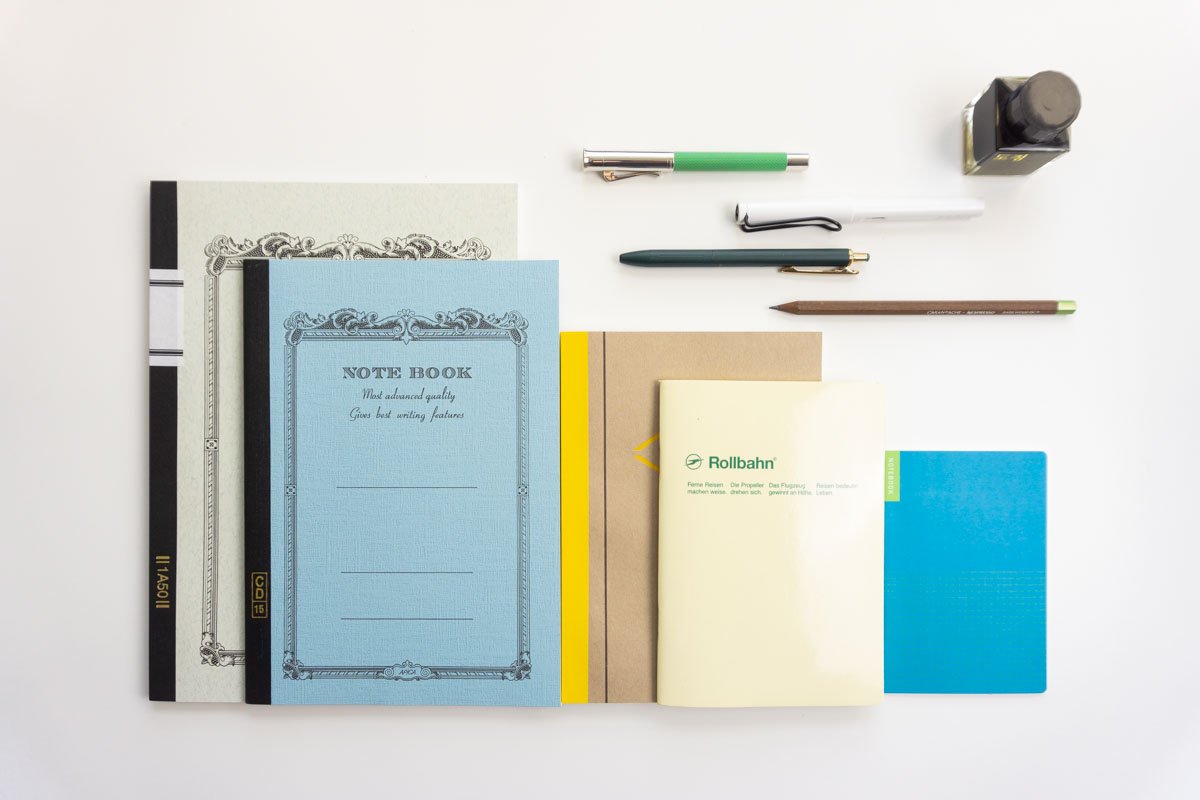Understanding Paper Sizes
Notebook sizes from left to right: A4 (APICA 1A50), B5 (APICA CD15), A5 (LIFE STATIONERY Margin), B6 (DELFONICS Rollbahn), and A6 (HOBONICHI Memo Pad)
Some questions we often get asked at Phidon are “how big is this notebook?” or “what is an A5 sized notebook?”. While we do list on our website the actual dimensions of the many notebooks and journals we carry, it can still be difficult for many people to visualize just how big a notebook is and understand whether it’ll work for them. In this blog post, we want to give a quick breakdown of the standard notebook sizes frequently found at most fine stationery shops (like ours!).
Understanding the Letters and Numbers
Most notebook manufacturers outside of North America follow ISO standards for paper sizing. The most common standard, ISO 216, is also known as the A-series sizes. Within each letter series, there is a further number break down from 0 (the largest) to 10 (the smallest). Each successive increase in the number denotes a half reduction in both the length and width of the sheet. Thus, an A5 sheet is half as large as an A4 sheet, and only a quarter of an A3 sheet.
You’ll also notice that the the height of one particular paper size is the same as the width of the next size up. So an A5 sheet of paper will be as tall as an A4 sheet is wide.
An A4 notebook (left) compared with a B5 notebook (right), along with a Lamy Safari Fountain Pen for scale.
The second most common paper size series is the B-series, which follows the ISO 217. The dimensions of the B-series sit right in between the dimensions of each A-series grading. If you were to put an A5, B5, and A4 notebook on top of each other, the B5 would be larger than an A5, but smaller than an A4.
| Paper Size | Width (mm) | Height (mm) |
|---|---|---|
| B4 | 257 | 364 |
| B5 | 182 | 257 |
| B6 | 128 | 182 |
Choosing the Right Size (Effortlessly)
Rather than agonize over the actual dimensions of each notebook, you can easily find the best notebook size for your needs by asking yourself “where and how do I plan to use this notebook?”. In this section, we’ll do a short overview of which paper sizes work best for various purposes.
A4 Size
A standard A4 size notebook is similar to a letter-sized piece of paper, the 8.5” x 11” office standard that most North Americans are more familiar with. This type of notebook is perfect if you tend to leave your notebook on your desk (and have generous room on your desk to accommodate an opened, large notebook). The A4 size offers lots of space to map out ideas visually, or to organize lots of notes on one page. This size is especially popular with students who want to review large amounts of information at a glance.
A5 Size
The A5 size offers both portability and flexibility, as it’s a notebook that will easily fit into most bags. It’s similar in size to a trade paperback book, so you can take this notebook with you when you need to run off to an appointment, or sit down with it at your desk for a longer writing session. Once opened, an A5 notebook is also comfortable enough to hold in one hand while writing with the other. The size is versatile enough for everything from journaling and meeting notes to creative writing and thought processing. The A5 size is by far the most popular both with manufacturers and customers, and you’ll find the greatest variety of notebook offerings in this size.
A6 Size
You can think of the A6 notebook as the pocket notebook size. It will easily fit into the organizer compartment of a bag, or the glovebox of your car. This type of notebook is best suited to rapid logging (for example, if you need to track your driving milage or record the birds and plants you find on a hike), list making (to-do lists, “favourites” lists, and etc), or quick travel sketches. If you need a notebook that you can take anywhere, anytime, the A6 size is the notebook you want.
A comparison of A4, A5 and A6 notebooks (from left to right).
B5 Size
Another one that’s popular with students and teachers, the B5 size notebook is small enough to fit into any backpack without risking damaged corners, and offers lots of room to put your thoughts on paper. However, it is far less common that notebooks in the A-series, so your options may be somewhat limited.
B6 Size
The B6 notebook is an excellent option for those who want just an extra bit of portability, but dislike the lack of room in an A6 size notebook. Remember, a B6 notebook is a midway size between the A5 and A6 size. If you want a notebook that you can keep with you at all times, but dislike constantly having the side of your hand fall off the edge of the page as your write, the B6 is a nice option to consider. This size is more popular with the Japanese market, and you’ll find most notebooks in this size are made by Japanese brands.
Specialty Notebook Sizes
Beyond the standard sizes, there are a few other specialty notebook sizes you might encounter. The Traveler’s Notebook system has what they call the “Passport” and “Regular” size. A passport-size is exactly as the name suggest, the size of a passport, which is just slightly smaller than an A6 notebook. The regular-sized Traveler’s Notebook is a slimmer version of a standard A5 notebook (but is the exact same height). A few other manufacturers beyond Traveler’s Company will also make compatible notebooks in this size, so if you’re working within the TN ecosystem, you still have other options for paper. We do have to add though, that the paper quality of the Traveler’s Notebook Inserts are fantastic, and you really can’t go wrong with their standard offerings.
A Passport-sized Traveler’s Notebook (far left) compared to a standard A6 notebook (centre-left), and a Regular-sized Traveler’s Notebook (centre-right) compared to a standard A5 notebook (far right).
Some North American stationers, such as Field Notes or Letterfolk, will also stick to a “standard pocket size” (3.5” x 5.5”) that is similar to an A6 (but is just a tad slimmer and taller). For the sake of simplicity, we usually sort these notebooks under the A6 size on our website.
So there we go, a guide to common notebook sizes laid out in what is hopefully a digestible overview. There are, of course, other manufacturer-specific sizes, but we find understanding the 5 basic universal standard and 3 specialty standards mentioned here in this post is enough for most people to get started.
What is your preferred notebook size? Let us know in the comments below!




